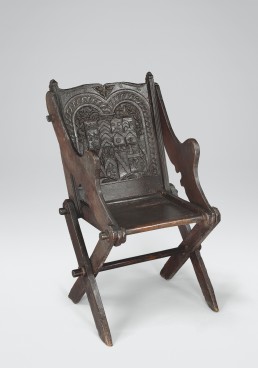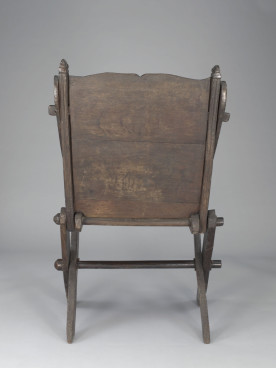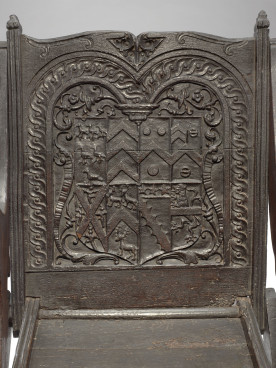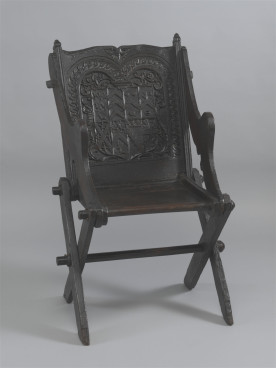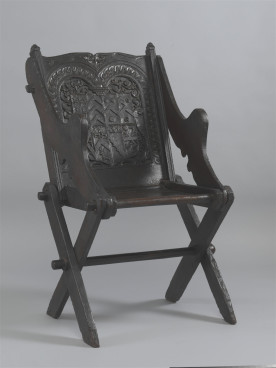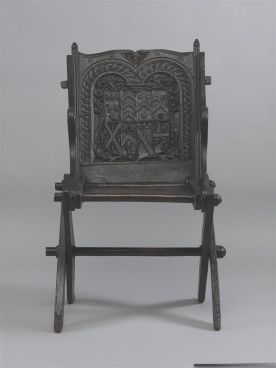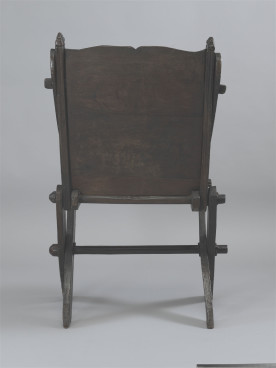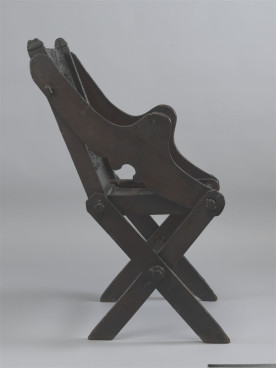Armchair, c.1540–75
Oak
The back is carved with the arms of sir John Arundell of Trerice, near Newquay, Cornwall. This chair can be disassembled and packed for travel.
Victor Chinnery Catalogue
Description
An oak demountable panel-back armchair of so-called ‘Glastonbury’ type, the horizontal boarded back panel shaped to the top with an inverted gothic pendant crocket over a finely carved coat of arms attributed to Sir John Arundell III of Trerice, Cornwall, surrounded by carved grotesques under a double arch carved with guilloche framing and set between moulded uprights with shaped finials; the down-scrolled arms linking with the lower framing enclosing a plain panelled seat raised on X-form legs linked by a later plain cross-stretcher, the whole held in place by socket joints with removable pins and wedges.
Dimensions
Ht: 40in, W: 25in, D: 25in.
Materials
Oak
Dating
c.1540-75
Condition
Generally good, with heavy encrustation of old black varnishes and some remains of old red polish. The top edge of the back panel trimmed. Some worm damage to seat. The lower cross-stretcher replaced.
Additional Remarks
The particular combination of quarterings in the arms is attributable to Sir John Arundell III (a favourite of Henry VIII, known as ‘Jack of Tilbury’) of Trerice in Cornwall. The house (now owned by the National Trust) was built c.1571-3 by Sir John IV, who included the arms of his father on an overmantel still in the Great Chamber at Trerice. There are slight differences between the arms as rendered on the chair and on the overmantel, but these are minimal enough to suggest that Sir John III may have been the original owner of the chair. The families represented seem to be Arundell, Trerise, Pelloure, Nanfan, Ligh, Rogers, St John and Jewe. As always, there are one or two small question marks over the exact links and affiliations between these families (the Arundells themselves are a complex family), but the attribution to Trerice is precise (Trerice Manor House, Cornwall in ‘In English Homes’, ed. Charles Latham, Country Life, London c.1905, 129-37; James Breslin, NT, pers. comm.)
Sir John Arundell III is buried beneath his memorial brass in Stratton church, near Bude in Cornwall. The brass shows him dressed in armour and standing in an attitude of prayer between his two wives, who together presented him with twelve children.
This rare chair is of the type traditionally know as a ‘Glastonbury’ chair, after the original now at the Bishop’s Palace in Wells, Somerset, by repute (though impossible to substantiate) believed to have originated as the property of John Arthur Thorne, the last Treasurer of Glastonbury Abbey who was executed in 1539. A chair similar to the Wells chair was owned by Horace Walpole at Strawberry Hill (present whereabouts unknown, illustrated by Gabriel Olive in an article, The Glastonbury Chair, in Regional Furniture 1994, pp. 24-41).
A very similar chair (ex-coll. John Fardon) was sold by Christie’s, King Street, London, 24 October 1991, Lot 51 (the coat of arms defaced and all identifying details removed, possibly including a date or initials). Similar chairs are owned by the Victoria & Albert Museum, London (Acc. No. W.232-1923); the Metropolitan Museum of Art, New York, Christchurch Mansion, Ipswich, Suffolk; and a private collector in Devonshire (this example initialled AH on the crest). A demountable chair of this type, with broadly similar cresting but plain back panel, was illustrated by Anthony Wells-Cole in Regional Furniture 1988, Fig. 8, found in an unidentified church in Cornwall.
The chair now in the collections of the Victoria & Albert Museum (Accession No. W.232-1923) is illustrated in various published sources, and recorded in the Victoria & Albert Museum Catalogue of English Furniture & Woodwork, Vol. II, 3, Plate 3 (HMSO 1930) with a significant history of Exeter ownership (“probably from a Somerset or Devonshire church” and subsequently in the possession of the Very Rev. Dr. Cowie, Dean of Exeter; Mr. Harry Hems of Exeter; Cecil, 2nd Lord Fisher of Kilverstone; and was given by Mrs Graham Reed-Mogg.
These chairs were probably designed as travelling or ‘campaign’ chairs, and may originally have been provided with leather carrying-cases into which they would have been packed for transport. The type is discussed in Victor Chinnery, Oak Furniture – The British Tradition, Woodbridge 1979, pp. 220-1, Figs. 3:1-3a; and by Gabriel Olive (see ref. above). Chinnery Fig. 3:1-3a was sold by Sotheby’s Olympia, London, Nyetimber Manor Sale, 27 September 2001, Lot 1045.
The type appears to derive from the folding cypresswood chairs of the Veneto (Adige), perhaps the most famous example of which is the one at Petrarch’s House in Arquà Petrarca, near Padua. This chair is discussed in Gabriel Olive 1994 (see ref. above), who reproduces an early woodcut of the chair (from Jacomo Philippo Tomasini, Petrarcha Redivivus, Padua 1635), Fig. 30. Though there are minor discrepancies between chair and woodcut, the chair appears to be the one still at Petrarch’s House, illustrated in Michelangelo Muraro & Paolo Marton, Venetian Villas, pub. Könemann, Cologne 1999, p. 79. Two further examples are illustrated in Wohnungskultur und Möbel der Italienischen Renaissance, pub. Julius Hoffman, Stuttgart 1926, p. 168, Fig. 372, where they are attributed to the Figdor Collection in Vienna; the same chairs are illustrated in Hermann Schmitz, The Encyclopaedia of Furniture, pub. Ernest Benn, London 1926, p.80. The front portion of a similar chair is shown in Hans Memling’s Bathsheba, in the Württembergische Staatsgalerie, Stuttgart.
Tudor Transitional
Provenance and References
The armorials suggest original ownership by Sir John Arundell III of Trerice, Cornwall (died 1561), a member of the Arundell family of Devon and Cornwall. Other chairs of this type also have circumstantial associations with Devon, whilst another bears the initials A & H (private collection, East Devon).
Exhibited at the BADA Armada Exhibition, Grosvenor House, 9-18 June 1988, (illustrated in catalogue England at the tyme of the Armada, Item 2).
Purchased from Alistair Sampson, London, 2 October 1989.

